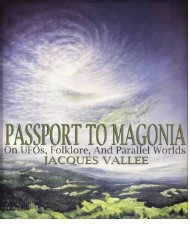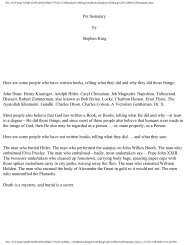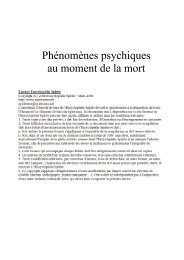extraordinary%20encounters
extraordinary%20encounters
extraordinary%20encounters
Create successful ePaper yourself
Turn your PDF publications into a flip-book with our unique Google optimized e-Paper software.
276 Y’hova<br />
Earth. In fact, his associate and onetime coauthor<br />
Desmond Leslie openly predicted it in<br />
an obituary he wrote for England’s Flying<br />
Saucer Review. Bryant, who claimed never to<br />
have heard of this famous contactee, produced<br />
a sketch of Yamski, who bore some resemblance<br />
to a youthful Adamski. Subsequently,<br />
Bryant brought forth physical evidence that<br />
he said the space people had given him.<br />
In 1967, Eileen Buckle, who had investigated<br />
the case, wrote about it in a thick book<br />
that essentially endorsed the case, notwithstanding<br />
growing evidence that Bryant had a<br />
hard time telling the truth even about the<br />
most mundane aspects of his life. Bryant died<br />
just after Buckle’s book was published. British<br />
ufologist Norman Oliver, who interviewed<br />
Bryant’s wife around that time, was told that<br />
Bryant’s story was bogus. He had based it on<br />
his considerable reading of UFO and occult<br />
literature and his extensive knowledge of<br />
Adamski’s claims. Oliver exposed the many<br />
dubious elements of the case in a self-published<br />
monograph.<br />
See Also: Adamski, George; Contactees<br />
Further Reading<br />
Buckle, Eileen, 1967. The Scoriton Mystery. London:<br />
Neville Spearman.<br />
Leslie, Desmond, 1965. “Obituary: George Adamski.”<br />
Flying Saucer Review 11, 4 (July/August):<br />
18–19.<br />
Oliver, Norman, 1968. Sequel to Scoriton. London:<br />
self-published.<br />
Y’hova<br />
According to the “extraterrestrialism” theories<br />
of Yonah Fortner (who wrote under the pseudonym<br />
Y. N. ibn Aharon), visitors from other<br />
worlds landed on Earth and interacted with<br />
its most advanced ancient civilizations, notably<br />
those of the Chaldeans and the Atlanteans.<br />
The Chaldeans, who possessed an<br />
advanced technology, were especially close to<br />
aliens, even intermarrying with one group, the<br />
Elohim. Another group was the Titans, who<br />
helped the Chaldeans vanquish the malevolent<br />
alien race known as the Serpent People.<br />
Eventually, warfare among alien races broke<br />
out on the Earth’s surface. In the midst of this<br />
conflict, one alien showed up around 1340<br />
B.C. Shaday Elili Athunu, otherwise known<br />
as Y’hova, befriended a local malcontent<br />
named Abraham, whom he promised to protect<br />
if he, his family, and his people followed<br />
him. Y’hova is known to humans as God.<br />
Fortner stated that the “God of Israel<br />
should not be confused with the general run<br />
of space visitors because he was either unique<br />
or very nearly unique in his decision to make<br />
a career among the people of earth. . . . [He]<br />
is a very august and ancient being . . . who<br />
comes from a higher order of being, a dimension<br />
beyond all known dimensions” (Steinberg,<br />
1977).<br />
Fortner outlined his theories in a series of<br />
articles published in Saucer News between<br />
1957 and 1960. His sources, he insisted, were<br />
rare and arcane Middle Eastern documents,<br />
but when challenged, he was unable to prove<br />
that they existed.<br />
Further Reading<br />
Ibn Aharon, Y. N. [pseud. of Yonah Fortner], 1960.<br />
“A Note on the Evolution of Extraterrestrialism.”<br />
Saucer News 7, 4 (December): 6–9.<br />
Steinberg, Gene, 1977. “Dr. Yonah Aharon—Originator<br />
of the Ancient Astronaut Theory.” UFO<br />
Report 4, 2 (June): 26–27, 74–78.





